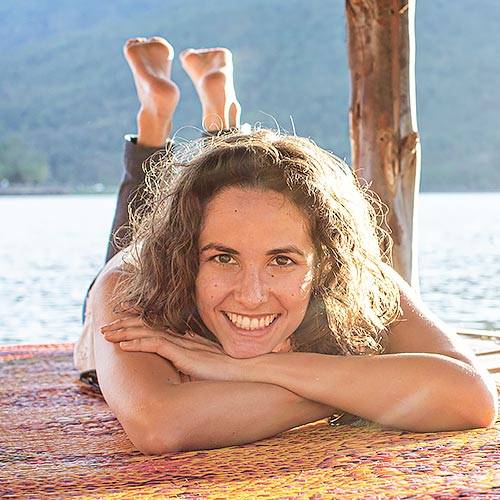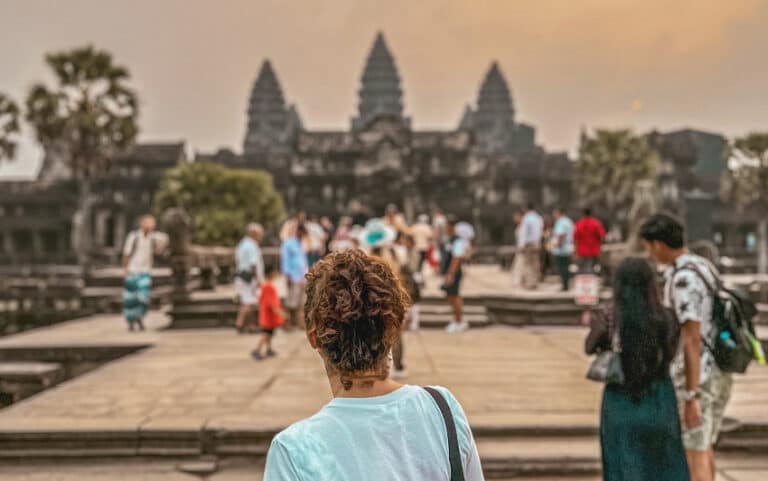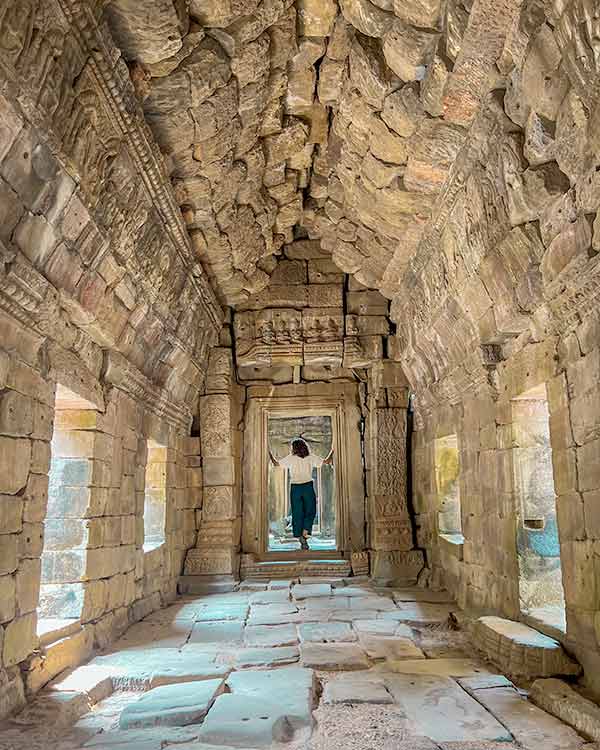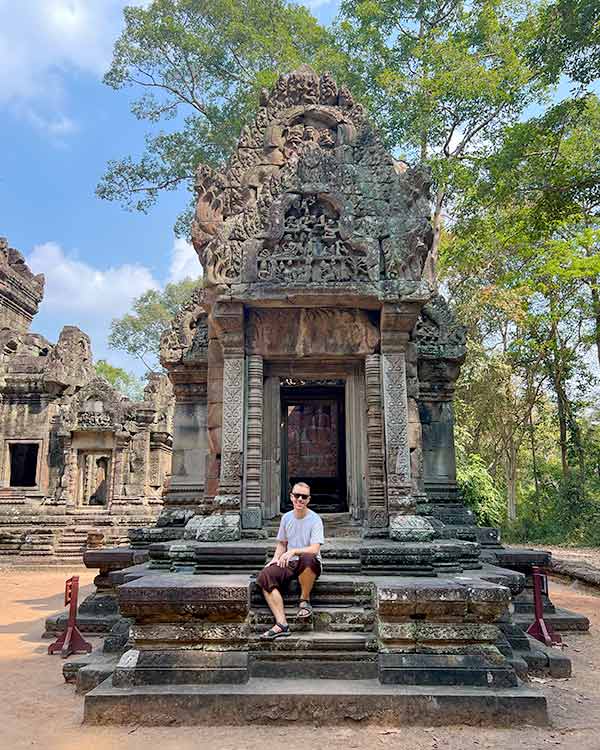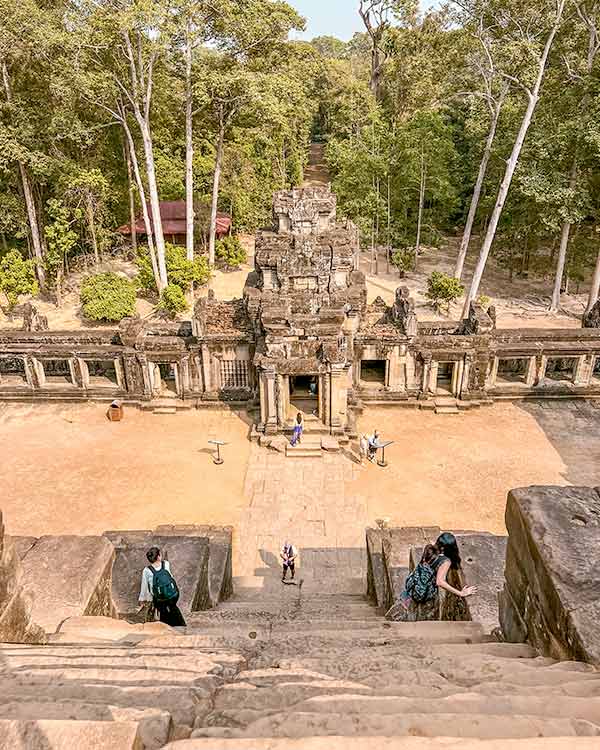Welcome to the ultimate backpacker’s guide to Siem Reap, a place that effortlessly ranks as one of the greatest destinations for backpackers. When I first traveled to Siem Reap, my expectations were modest. As many of us, my interest was the one and only Angkor Wat.
What I discovered was much more: It was an extraordinary world of adventure, culture, and unparalleled beauty. I experienced incredibly friendly locals, a great food scene, and a very special ambiance that every backpacker will love.
This guide is your compass to navigating Siem Reap’s treasures, all based on my own experience.
Most travelers just check out the temples of Angkor and then leave Cambodia behind. However, after having traveled 10 days around Cambodia, I urge you to spend a bit more time in this country and Siem Reap. Stick around for an extra 2-3 days in Siem Reap and you will get so much more out of it.
Guide Index
Travel Costs & Suggested Budget: Detailed Breakdown
This budget guide aims to help you plan your trip to Siem Reap, offering a blend of cultural experiences, exploration, and insight into daily expenses.
Suggested Budget per person per day
- Low – $22
- Middle – $36
- High – $50+
Detailed Costs
These prices are estimates and can vary based on factors like location, seasonal changes, and personal spending habits. Always check for the most current prices and deals when planning your trip.
Accommodation
- Low – dorm in a Hostel: $9
- Middle – private room in a hostel, budget hotels: $25-35$
- High – Apartments or luxury hotels $45+
Food and Drink
When looking to save money on food, in South East Asia you should rely on street food. This is your best tip to save money on food. In Siem Reap (and Cambodia) there are also bakeries. These are the perfect places to find a snack if you have a sweet tooth.
Cheap Food
- Basic meal: about $2-3 for a simple dish (vegetables/chicken and Rice).
- in Angkor: a simple dish like rice with vegetables or chicken is about $5 in Angkor. Nearby the most famous temples (like Angkor Watt, Bayon) is a bit more expensive.
Western food
- Breakfast: A simple coffee and pastry might cost you $3 to $6. For something more filling, expect to pay $8-$10.
- Casual dining: ranges from $10 to $16.
- Mid-range restaurants: can charge up to $30 per person, not including drinks.
Coffee
- Low – Coffee on a street stand or local café: $1 to $2
- Middle – Cappuccino or latte in a cafe: $1.5 to $2.5
- High – Specialty coffees or in very touristy areas: $2.5+
Beer
- Low – Cheap places on Pub Street or supermarket: Less than $1
- Middle – In the hostel bar or : $2- $4
- High – upscale bars or very touristy areas: $5+
Transportation
Siem Reap lacks public transport, which means you’ll have to use private bus companies, taxis, Grab, Tuk-tuks. Read more about transportation on the how to move around section.
Activities
- Angkor: The tickets can be purchased directly on the website and you will get them directly on your email. Bear in mind you’ll have to upload a photo of yourself as well as passport details. Around Angkor, staff will check the ticket at different checking points.
- 1-day pass: $37 (valid for 1 entry during 3 days)
- 3-day pass: $62 (valid for 3 entries during 10 days)
- 7-day pass: $72 (valid for 7 entries during 30 days)
- Museums: the Angkor Museum is a good visit, with an entrance fee of $12. It provides a deep dive into the history of the Angkor sites.
- Tours: there are different tours to add to your Siem Reap experience, from Angkor tours to day trips to fish villages. A Tuk-tuk tour to Angkor, usually lasting about 5 hours, costs around $20. Car tours are also available but at a higher cost. Another option is to rent a bike or a motorbike and become an explorer.
Explore Siem Reap: Things to do
Siem Reap’s Icons on a Budget
If you go to Siem Reap to visit Angkor, prepare to pay $37 for a day entry ticket. You can buy the ticket on the official website. That way, you’ll receive it directly to your email and you won’t have to queue at the ticket counter.
How Many Days Should You Visit Siem Reap?
For those on a budget, you can see the main temples in just 1 day.
However, if you can, I recommend staying in Siem Reap for 2-3 days. These extra days give you a chance to explore more than just Angkor. And believe me, there is so much to explore.
My perfect itinerary for Angkor
- Day 1: Dive deep into the Angkor Wat complex. Start early to catch the sunrise and visit the most famous temples:
- Bayon Temple: Known as the temple of the faces, it’s famous for its many large stone faces smiling mysteriously.
- Ta Prohm Temple: Made famous in the movie “Lara Croft: Tomb Raider,” this temple is known for the giant trees growing out of the ruins.
- Angkor Wat: Cambodia’s icon. Although popular for sunrise visits, the weather can be hit or miss. Consider visiting in the afternoon when it’s cooler and less crowded. I found it peaceful around 4:30 pm, perfect for taking photos without many people around.
- Day 2: Explore more temples or revisit your favorites at a slower pace. Lesser-Known Gems:
- Banteay Kdei: A quieter temple that offers a glimpse into the past without the crowds.
- Ta Som: Famous for its nature-overrun backdoor entrance, where a tree surrounds the doorway.
- Phnom Bakheng: Known for its spectacular sunsets. It’s limited to 300 visitors at a time, so make sure to arrive early.
- Banteay Srei: About 35 km from Siem Reap, this temple is renowned for its intricate red sandstone carvings. Worth the drive if you have time.
- Day 3: Take a break from temple-hopping. Visit the Landmine Museum to learn about Cambodia’s recent history. You could also check out the local markets, take a cooking class, or enjoy a day trip to nearby attractions like the floating villages on Tonle Sap Lake.
This schedule allows you to experience a mix of historical sites, cultural insights, and the natural beauty surrounding Siem Reap. Plus, it gives you some flexibility to relax.
Ticket Options for Angkor
Every foreigner needs to purchase entrance tickets for Angkor. There is only one type of ticket that is valid for all temples and the entire area. However, you need to choose between how many days you want to visit Angkor:
- One-Day Pass: Perfect for those on a tight schedule or who want a taste of the ancient world. This pass allows you to explore the main temples, including the iconic Angkor Wat, all in a single day. It’s a whirlwind tour, so start early to make the most of it!
- Two-Day Pass: There is no two-day pass available!
- Three-Day Pass: This is the sweet spot for many travelers. Valid for use over 10 days, it gives you the flexibility to explore at a more leisurely pace. You can dive deep into the heart of Angkor Wat, wander through the mystical faces of Bayon, and get lost in the jungle-clad ruins of Ta Prohm with time to spare for the lesser-known temples.
- Seven-Day Pass: For the true explorers and history buffs, this pass is valid for over one month, allowing you to fully go into in the wonders of Angkor. With this pass, you can take your time uncovering hidden gems, revisiting your favorite spots at different times of the day, and soaking in the ancient vibes.
Purchasing Your Ticket:
- Online: Buying your ticket online is highly recommended. It’s the most convenient way to ensure you’re all set for your adventure. Plus, you can avoid the queues and get straight to exploring. You can buy it on the official website and it costs the same as on the ticket counter
- Ticket Office: If you decide to purchase your ticket in person, you can do so at the official ticket office. Just remember, especially if you’re buying a one-day pass, to get there early to maximize your time among the temples.
Important: When visiting the area, there are several checking points. Here you need to stop and show your tickets to be scanned.
Beyond the Temples
Most people visit Siem Reap mainly for the ancient ruins, but there are more fun things to do in Siem Reap. The following activities offer a deeper dive into Cambodian culture, history, and efforts towards a better future, rounding out your Siem Reap adventure with meaningful insights and unforgettable experiences.:
- Pub Street: an interesting place for an evening stroll, offering a variety of bars, massage parlors, and even unusual experiences like a “fish pedicure,” where Garra Rufa fish nibble away your feet dead skin.
- Apsara dance performances: these shows give more insight into Cambodian culture.
- Phare circus: offering an electrifying blend of traditional and modern theatre, comedy, music, dance, and acrobatics. It’s a high-energy performance that tells Cambodian stories in a captivating way. Shows kick off at 8 p.m. nightly, making for a perfect evening activity in Siem Reap.
- The Landmine Museum: provides a sobering look at Cambodia’s impacts of the Civil War and ongoing recovery efforts.
- Cooking classes: learn how to prepare traditional Cambodian dishes.
- Day trips to Tonle Sap Lake: the floating villages offer a glimpse into the local way of life.
- APOPO Visitor Center: learning about the Hero Rats in APOPO is something truly unique. This Visitor Center introduces you to the rats trained to detect landmines in Cambodia. You’ll not only learn about these incredible animals’ contributions to making the country safer but also see a demonstration of how they work. You might even find rats cute at the end of the tour, even want to hold one.
Where to Stay on a Budget
Finding a great place to stay is key to enjoying Siem Reap. Given the heat, accommodations with a swimming pool are a huge plus for cooling off after a day of exploration. Here’s a quick guide to my top choices.
Hostels
The Cambodia hostel scene is awesome. They are about community, comfort, and (maybe) finding some fellow travelers to keep exploring the country. Here are some top picks known for their excellent value, prime locations, and swimming pool:
- Lub D: Known for its vivid atmosphere and friendly staff. Comfortable rooms and great common areas for meeting fellow travelers. The swimming pool is next to the bar. Make sure you spin the wheel, you might earn a free cocktail. It has a bit more party vibe than the others, but you can also just relax.
- Onederz Siem Reap: Popular among a diverse crowd. It offers private rooms, two swimming pools, and a large shaded communal area. This is a great place for “adult” travelers who love a bar but not too much party. Personally, I feel this is the best place for 30+ travelers.
- The Twizt Lifestyle Hostel: Features glamorous vibes with daily live music on the rooftop. The pool offers stunning sunset views on clear days. It is not as social, but super clean and laid-back. It felt a bit more like a hotel. Their rooftop swimming pool had the best sunset views!
Read here my guide to the best hostels in Siem Reap.
Alternative Budget Accommodations
Beyond hostels, Siem Reap has many guesthouses, and budget hotels offering more privacy. A notable mention to
Rithy Rine Angkor Residence. A great budget hotel option with good facilities.
Tips for Choosing Accommodation
- Book in Advance: Especially during high season, to secure a good spot.
- Location Matters: Siem Reap is not big, but after a long day walking around Angkor you’ll be tired. I recommend you to stay near Pub Street for convenience but far enough to avoid noise.
- Read Reviews: Use Hostelworld, Booking.com, and Hostels for reliable and updated insights on cleanliness, safety, and service.
Eating and Drinking
Siem Reap is great for travelers on a budget, with plenty of options for affordable meals and drinks.
Affordable Eats
- Night Markets: A hotspot for cheap, delicious dishes, open from 5 PM to around 10-11 PM. The night market is located near the riverside and it is full of locals too. Make sure you choose a stall with food turnover to get the fresher products. To avoid getting sick, do not drink the free water they’ll offer you. Bring your water or buy bottled drinks.
- Bakeries: Cambodian bakeries are perfect for both sweet and savory snacks on the go. Look out for them throughout the city for a quick, tasty, and budget-friendly bite. My favorite one is Le Pain du Cour.
- Local Restaurants: Many local eateries offer dishes for as low as $3. If you want a nicer restaurant but are looking to stretch your budget further, consider skipping drinks and just enjoying the food.
Cheap Drinks and Nightlife Spots
- Pub Street: The go-to place for budget-friendly nightlife, where some bars offer beers for less than $1. It’s lively and packed with options to party until the early hours.
- Happy Hour Deals: Keep an eye out for happy hour promotions on Pub Street, where beer prices can drop to as low as 50 cents. It’s a great way to enjoy the nightlife without spending too much.
How to get around Siem Reap
Getting Around Siem Reap
Siem Reap lacks public transport, meaning alternative methods are needed:
- Electric Tuk-tuk: Similar to those in Sri Lanka, you can negotiate a fare or use the Grab app. Rates vary.
- Remorque tuk- tuks: A traditional Cambodian tuk-tuk, slightly pricier than electric ones but still affordable. Remember to negotiate the fare. You can also book them through Grab app.
- Bike Rentals: Renting a bike costs about $7 a day, including a lock and a helmet. You must ask for them.
- Motorbike Rentals: A day’s rental is around $10, with distance and damage clauses to be aware of.
- Walking: if you stay around Pub Street, you’ll be able to walk to some places. As it gets very hot in Siem Reap, do not hesitate to use Grab and Tuk-Tuks for further distances. It is quite cheap and very convenient.
Cheapest Way to Get To and From the International Airport (SAI)
Since October 2023, Siem Reap International Airport (REP) changed to the new airport: Siem Reap-Angkor International Airport (SAI)
There is a bus company offering transfers from the airport to Siem Reap at $8 per person. Bear in mind if you are traveling as a couple or in a group a tuk-tuk for two is around $16, offering a direct ride to your accommodation.
Traveling around Cambodia
For those backpacking in Cambodia, there are 2 ways you can move to your next destination:
- Bus Travel: Buses, like Giant Bus or Virak Buntham, are an affordable way to travel across Cambodia. A trip from Siem Reap to Phnom Penh is about $8, while a sleeper bus costs around $17. You can book the tickets through 12goasia too, even it will cost you a bit more.
- Taxis and Private Cars: Taxis offer comfort but at a higher price. For flexibility, a private car can be booked, for example, from Battambang to Siem Reap at about $65.
Best Time to Visit Siem Reap
Siem Reap receives tourists all year long, but there are 2 months when the accommodation prices are the highest: December and January. This means accommodation can be more expensive, there are more visitors, and bargaining for transportation prices might be tougher.
Siem Reap is warm or hot all year, with the biggest change being how much it rains.
- Dry season: from November to March.
- Wet season: from June to September. Try to avoid it because it rains a lot. That means some roads are flooded and there are more mosquitos.
The best time to visit Siem Reap on a budget is February and March. It is still dry season, but prices are more affordable.
Calendar of Events
Some special times and holidays will make prices skyrocket. As a backpacker, knowing these dates can help you plan your trip better. You might want to join in the festivals or choose a quieter time to visit. The decision is yours:
- Khmer New Year (April): the dates change each year as it depends on the lunar calendar. It lasts 3 days and is a big holiday. Lots of businesses close, prices of accommodation and restaurants go up, and finding open restaurants might be hard.
- Birth of Buddha (April 28): Many locals visit temples to pray and listen to monks. Angkor and nearby temples get very busy.
- Royal Ploughing Ceremony (May 2): an important cultural event.
- King Sihamoni’s Birthday (May 13-15): This will affect you only if you’re in Phnom Penh, as the ceremonies occur in the kingdom’s palace.
- Ancestors’ Day from (September 7-11): Families go to temples to honor their ancestors.
- Constitution Day (September 24): It’s a public holiday, and many shops and restaurants might be closed.
- Independence Day (November 9): is another public holiday.
- Water Festival (November 20-23): Expect boat races and celebrations near Tonle Sap Lake. This event draw crowds around the area for days.
Backpacking Essentials & Safety Tips
Safety and Scams: Staying Secure
Siem Reap is largely safe for backpackers, but it’s smart to be aware of common scams:
- Tuk-tuk Overcharges: Some drivers might try to overcharge tourists. To avoid being overcharged by tuk-tuk drivers, check the Grab app for fair prices or book your ride directly through it to skip bargaining.
- Fake Blessings: Beware of individuals impersonating monks and asking for donations. Genuine monks do not solicit donations actively.
- Transportation Scams: For airport transfers or day tours, book through reputable websites or directly with your accommodation. There are some “fake companies” that will charge you and never show up.
- Baby Formula Scam: Be cautious if approached by young mums and teenagers or kids asking to buy baby formula. This is often a scam where the formula is returned to the store for a refund.
- Fake Orphanages: Many Cambodian orphanages are scams, exploiting children for donations. UNICEF reports most children in these orphanages have living parents but are kept in poor conditions to elicit donations.
Cultural Etiquette and Tips
It’s crucial to approach Siem Reap with a mindset of respect and understanding towards local culture and human rights. Avoid participating in or supporting any activities that may exploit or violate human rights. Engaging with the community respectfully and peacefully enriches your travel experience and supports the ethical treatment of all individuals. Here’s what you need to know to respect local customs during your stay in Siem Reap.
- Greetings: The customary greeting is to clasp your hands and bow slightly with a smile.
- Temple Etiquette: Remove shoes before entering certain temple areas (also in Angkor) and dress modestly by covering shoulders and knees to respect local customs.
- Physical Contact: Avoid gestures like pointing or touching someone’s head, as these are considered disrespectful.
- Endangered Species Products: Do not buy products made from endangered animals, like ivory, rhinoceros horns, or crocodile skins,…This only contributes to their suffering.
- Currency Use: Cambodian transactions often use US dollars and Riels. Ensure your US bills are in really good condition; torn or old bills (pre-1996) may not be accepted.
- Interacting with Local Children: Avoid giving money to children begging or selling items, as this discourages them from valuing education. It is a sensitive topic.
- Taking Photos of Local Cuisine: Before photographing exotic bugs at night markets, ask permission to avoid potential charges.
Sustainable Travel Tips
Traveling sustainably in Siem Reap not only enhances your experience but also helps preserve this stunning area’s environment and cultural heritage.
- Support Local Businesses: Opt for dining at local eateries and cafes that use locally sourced and seasonal ingredients, minimizing the environmental impact of food transportation.
- Nature Conservation: Respect the majestic Angkor site by leaving no trace, avoiding climbing on the ruins to prevent damage, and helping to preserve the natural surroundings.
- Reduce, Reuse, Recycle: Bring along a reusable water bottle to cut down on single-use plastics. Many places offer water refill stations. Also, prefer using a glass for your beverages in restaurants.
- Choose Reputable Businesses: Support restaurants and cafes committed to fair trade and ethical practices, such as providing fair wages and healthcare to their staff. A great example is The Little Red Fox Espresso, known for its excellent food and ethical business model.
- Respect Cultural Heritage: Dress appropriately when visiting temples, covering your knees and shoulders, to show respect for the local culture.
Embracing these sustainable practices ensures your visit contributes positively to Siem Reap’s preservation and the well-being of its community.
Things Not to Do in Siem Reap
Siem Reap is an inviting destination, yet there is some useful advice to make your experience even better:
- Avoid Keeping Cambodian Riels: Spend your Riels before leaving Cambodia. It’s almost impossible to exchange this currency outside the country.
- Be Cautious with Dining on Pub Street: While Pub Street is worth visiting, dining there might not offer the best value. Many places serve overpriced Western food. Look for local eateries off the main drag for authentic and affordable meals.
- Don’t Pre-Book All Tours: Unlike destinations in Europe where booking ahead is essential, Siem Reap’s tour prices often remain stable, and last-minute deals are common. Online offerings might be pricier than what you’ll find locally.
- Explore Temples Independently: If you’re looking to save money, consider self-guided tours of Angkor’s temples. Armed with information from videos or books, you can enjoy the sites at your own pace. However, remember that a knowledgeable guide can enrich your understanding of these historic places.
- Be Cautious with Tap Water: Stay hydrated, but avoid tap water unless confirmed safe by your accommodation. Around Cambodia bottled water is a safer choice to prevent health issues.
Following these tips can help you navigate Siem Reap more smoothly, making your trip both enjoyable and economical.
Resources and Planning
Here are some essential tools to plan your Siem Reap trip.
Accommodations:
- Hostelworld
- Hostelz
- Airbnb
- Booking
Transportation:
- 12goAsia
- GiantBus
- Vireak Buntham Express
- Passapp: The local ride-hailing app similar to Grab in Cambodia.
- Grab app: An app that allows you to book rides for tuk-tuks and taxis at fair, metered rates without needing to haggle.
Navigation:
- Organic Maps: detailed, offline maps.
Tours and Activities:
- Local Travel Companies: ask your accommodation for reputable companies before booking any trip/ ride.
- Hostel Tours
Language and Communication:
- Google Translate
- Speak & Translate
Conclusion: Your Budget-Friendly Siem Reap Adventure
Siem Reap offers an authentic slice of Cambodia, showcasing its marvelous temple, resilience, culture, and the incredible warmth of its people. The city proves that true travel experiences don’t have to drain your savings. With a spirit of adventure, you can dive deep into the essence, savoring its flavors, marveling at its history, and creating memories that resonate long after you’ve returned home.
Siem Reap should not just be a stopover to check a famous temple, should be a chapter in your travel story. So, pack your bags, bring your curiosity, and set forth on a journey to Siem Reap.
Safe travels!

